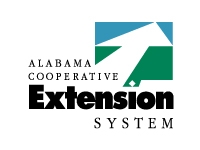Alabama Cooperative Extension System facts for kids

Official Alabama Cooperative Extension System logo (2012)
|
|
| Agency overview | |
|---|---|
| Formed | 1914 |
| Jurisdiction | Alabama |
| Headquarters | Auburn, Alabama and Normal, Alabama |
| Employees | 800 |
| Agency executives |
|
| Parent agency | Alabama A&M University and Auburn University |
| Website | http://www.aces.edu/ |
The Alabama Cooperative Extension System (Alabama Extension) helps people in Alabama. It shares useful information from two big universities. These are Alabama A&M University and Auburn University. They are called "land-grant" universities.
Alabama Extension has over 800 people working for it. They have offices in all 67 counties in Alabama. They also have offices in nine big cities. They work with the Alabama Agricultural Experiment Station. Together, they have six special centers. These centers are in different parts of the state.
Since 2004, Alabama Extension has worked in regions. This means experts work across several counties. They focus on specific topics. Local county offices still help people in their areas. They work with the regional experts.
Contents
How Alabama Extension Works
In 1995, Alabama Extension became the first "unified" program in the country. This means it brought together resources from different universities. A court decision helped make this happen. It was called Knight vs. Alabama. This decision combined the programs of Alabama A&M, Auburn, and Tuskegee universities. They now work together as partners.
A director leads this combined effort. The presidents of Alabama A&M and Auburn universities choose this director. The director is like the main boss. They have offices at both university campuses.
The court ruling asked for a new and bigger mission. It wanted Extension to help more people. This included people in cities and different backgrounds. So, they added new leaders. One leader focuses on traditional programs. Another leader focuses on urban and new programs. This new leader helps reach all people in Alabama.
Leaders of Alabama Extension
Here are the people who have led the Alabama Cooperative Extension System:
- J. F. Duggar, 1914-1920
- Luther N. Duncan, 1920-1937
- P. O. Davis, 1937-1959
- E. T. York, 1959-1961
- Fred R. Robertson, 1961-1971
- Ralph R. Jones, 1971-1974
- W. H. Taylor (Acting), 1974-1975
- J. Michael Sprott, 1975-1983
- Ray Cavender (Acting), 1983-1984
- Ann E. Thompson, 1984-1994
- W. Gaines Smith (Interim), 1994-1997
- Stephen B. Jones, 1997-2001
- W. Gaines Smith, 2001-2011
- Gary Lemme, 2011–present
Big Changes in 2004
In 2004, Alabama Extension changed how it worked. For many years, local county agents did most of the work. They knew a little about many different topics. But times changed. More people moved to cities. There were fewer farms. Also, the World Wide Web made it easy to get information online.
Because of these changes, Alabama Extension switched. They started using "regional agents." These agents are experts in one of 14 main areas.
Regional Experts
Regional Extension agents work together. They work across different regions and topics. They also work with other experts and groups. These groups include the Alabama Farmers Federation and the Alabama Forestry Commission. This helps them share programs across the whole state.
Local Offices Still Help
Even with regional experts, Alabama Extension still has offices. They have an office in all 67 counties. A coordinator leads each county office. They work with regional agents. This helps them bring programs to people in their local area.
How Extension Gets Money
Cooperative Extension programs across the country get money from different government levels. Alabama Extension also gets money this way. But they are also looking for new ways to get support. This often comes from grants and fees.
History of Alabama Extension
Many people think Cooperative Extension started in 1914. That's when the Smith–Lever Act of 1914 was passed. This law gave federal money to universities for Extension work. In a formal way, that's true.
But the idea of Extension started much earlier. It goes back to the late 1700s. After the American Revolution, rich farmers started groups. They held meetings to share farming tips. Sometimes, university professors even gave talks. This was like Extension work, but over a century before it officially began.
These efforts became more organized over time. By the 1850s, many schools held "farmer institutes." These were public meetings. Speakers would talk about new farming ideas.
Images for kids




